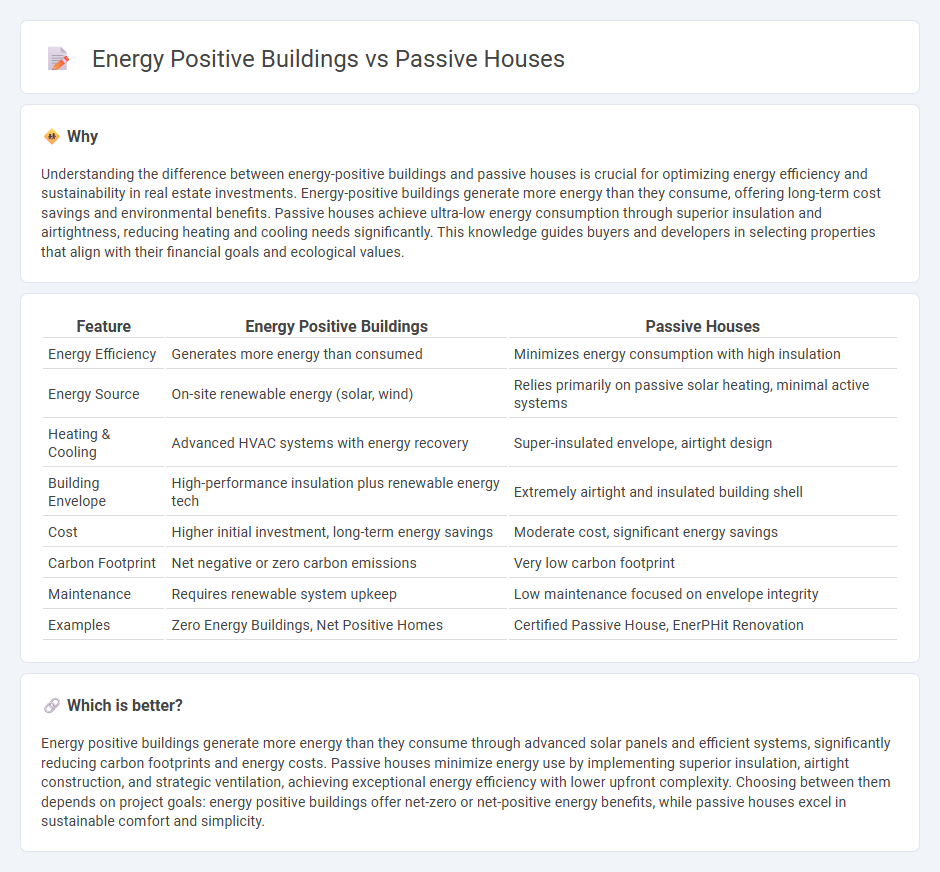
Energy-positive buildings generate more energy than they consume through renewable sources, significantly reducing carbon footprints and utility costs. Passive houses emphasize airtight construction, superior insulation, and heat recovery ventilation to achieve minimal energy consumption without active energy generation systems. Discover how these innovative building designs are transforming sustainable real estate development.
Why it is important
Understanding the difference between energy-positive buildings and passive houses is crucial for optimizing energy efficiency and sustainability in real estate investments. Energy-positive buildings generate more energy than they consume, offering long-term cost savings and environmental benefits. Passive houses achieve ultra-low energy consumption through superior insulation and airtightness, reducing heating and cooling needs significantly. This knowledge guides buyers and developers in selecting properties that align with their financial goals and ecological values.
Comparison Table
| Feature | Energy Positive Buildings | Passive Houses |
|---|---|---|
| Energy Efficiency | Generates more energy than consumed | Minimizes energy consumption with high insulation |
| Energy Source | On-site renewable energy (solar, wind) | Relies primarily on passive solar heating, minimal active systems |
| Heating & Cooling | Advanced HVAC systems with energy recovery | Super-insulated envelope, airtight design |
| Building Envelope | High-performance insulation plus renewable energy tech | Extremely airtight and insulated building shell |
| Cost | Higher initial investment, long-term energy savings | Moderate cost, significant energy savings |
| Carbon Footprint | Net negative or zero carbon emissions | Very low carbon footprint |
| Maintenance | Requires renewable system upkeep | Low maintenance focused on envelope integrity |
| Examples | Zero Energy Buildings, Net Positive Homes | Certified Passive House, EnerPHit Renovation |
Which is better?
Energy positive buildings generate more energy than they consume through advanced solar panels and efficient systems, significantly reducing carbon footprints and energy costs. Passive houses minimize energy use by implementing superior insulation, airtight construction, and strategic ventilation, achieving exceptional energy efficiency with lower upfront complexity. Choosing between them depends on project goals: energy positive buildings offer net-zero or net-positive energy benefits, while passive houses excel in sustainable comfort and simplicity.
Connection
Energy positive buildings and passive houses are interconnected through their focus on maximizing energy efficiency and reducing environmental impact in real estate development. Passive houses utilize advanced insulation, airtight construction, and energy-efficient windows to minimize energy consumption, creating ultra-low-energy buildings that often generate surplus energy, which classifies them as energy positive. Integrating renewable technologies like solar panels in passive houses enables these structures to produce more energy than they consume, advancing sustainable real estate solutions.
Key Terms
Energy Efficiency
Passive houses achieve energy efficiency by minimizing heat loss through superior insulation, airtight construction, and advanced window technology, reducing heating and cooling demands by up to 90%. Energy positive buildings go further by integrating renewable energy systems like solar panels and wind turbines, generating more energy than they consume, which supports grid resilience and net-zero energy goals. Explore more about how these building standards transform sustainable architecture and energy management.
Net Energy Production
Passive houses prioritize minimizing energy consumption through superior insulation, airtight construction, and energy-efficient systems, resulting in near-zero net energy use. Energy positive buildings, however, produce more energy than they consume by integrating renewable energy sources like solar panels and wind turbines, achieving net energy production that benefits the grid. Explore the key technologies and design principles that differentiate these building concepts to optimize your sustainable construction projects.
Building Envelope
Passive houses utilize highly insulated building envelopes with airtight construction to minimize heat loss and maximize energy efficiency. Energy positive buildings integrate advanced materials and technologies within the building envelope, such as solar panels and dynamic insulation, to generate more energy than they consume. Explore the innovative design strategies and material advancements driving the evolution of sustainable building envelopes.
Source and External Links
What is Passive House? - Passive House is a performance-based building certification focused on drastically reducing energy use for heating and cooling, providing over 90% energy savings for space conditioning and improved comfort and air quality through a highly insulated, airtight design with efficient ventilation systems.
Passive House is a building standard - Passive Houses achieve up to 90% energy savings in space heating and cooling compared to typical buildings by using superior insulation, airtight envelopes, heat recovery ventilation, and passive solar strategies to maintain comfortable indoor temperatures year-round.
Here's What You Need To Know About Passive Houses - Passive Houses are airtight, well-insulated buildings with advanced ventilation that act like a thermos to maintain internal temperatures with minimal energy input, typically saving 40-60% on energy compared to conventional homes.
 dowidth.com
dowidth.com